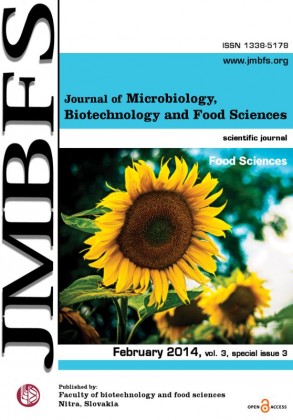CONTENT OF MERCURY AND LEAD IN LEAVES OF SPINACH (SPINACIA OLERACEA, L.)
Keywords:
mercury, lead, spinach, food contaminationAbstract
Spinach is one the most nutritious leafy vegetable. Only 22 calories per 100 grams, a high amount of protein, carbohydrate and fat make it very suitable ingredient in reduction diets. For a wealth of minerals and vitamins in addition it has an extraordinary nutritional value. 100 g contains two-thirds of its daily requirement of vitamin A, virtually the entire daily need for folic acid, half the dose of vitamin C, almost a quarter of the daily needs of more than a quarter of the needs of iron and magnesium.According to some studies, it is a good remedy for cancer prevention. In spinach are found in high concentrations of carotenoids, which protect cells from destruction, and so help to antiaging. Lutein-carotenoided pigment, an adequate supply may delay the emergence of degenerative diseases of the retina of the eye. In the framework of monitoring, we have focused on the analysis of the levels of lead and mercury in 7 samples of spinach from the commercial network of the Slovak republic. The lead content in all samples was 0.00 mg.kg-1, mercury content was in the range of 0.0019 – 0.0054 mg.kg-1. From the point of view of the sanitary evaluation of the HPQ for the content of lead and Hg was not exceeded in either sample.
Downloads
Download data is not yet available.
Downloads
Published
2014-02-01
How to Cite
Tóth, T., Kopernická, M., StanoviÄ, R., Musilová, J., BajÄan, D., Slávik, M., Harangozo, ĽuboÅ¡, & Zupka, S. (2014). CONTENT OF MERCURY AND LEAD IN LEAVES OF SPINACH (SPINACIA OLERACEA, L.). Journal of Microbiology, Biotechnology and Food Sciences, 3(special issue 3 (Food Sciences), 298–299. Retrieved from https://office2.jmbfs.org/index.php/JMBFS/article/view/7595
Issue
Section
Food Sciences
License
Copyright (c) 2014 Tomáš Tóth, Miriama Kopernická, Radovan StanoviÄ, Janette Musilová, Daniel BajÄan, Marek Slávik, ĽuboÅ¡ Harangozo, Stanislav Zupka

This work is licensed under a Creative Commons Attribution 4.0 International License.
All papers published in the Journal of Microbiology, Biotechnology and Food Sciences are published under a CC-BY licence (CC-BY 4.0). Published materials can be shared (copy and redistribute the material in any medium or format) and adapted (remix, transform, and build upon the material for any purpose, even commercially) with specifying the author(s).

